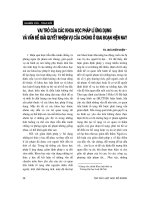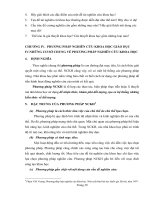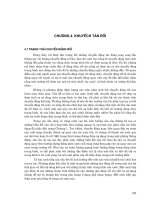Slide khóa học pháp lý chương 4 data acquisition
Bạn đang xem bản rút gọn của tài liệu. Xem và tải ngay bản đầy đủ của tài liệu tại đây (1.63 MB, 76 trang )
.c
om
du
o
ng
th
an
co
ng
Guide to Computer Forensics
and Investigations
Fourth Edition
cu
u
Chapter 4
Data Acquisition
CuuDuongThanCong.com
/>
.c
om
Objectives
cu
u
du
o
ng
th
an
co
ng
• List digital evidence storage formats
• Explain ways to determine the best acquisition
method
• Describe contingency planning for data acquisitions
• Explain how to use acquisition tools
CuuDuongThanCong.com
/>
.c
om
Objectives (continued)
cu
u
du
o
ng
th
an
co
ng
• Explain how to validate data acquisitions
• Describe RAID acquisition methods
• Explain how to use remote network acquisition
tools
• List other forensic tools available for data
acquisitions
CuuDuongThanCong.com
/>
.c
om
ng
co
cu
u
du
o
ng
th
an
Understanding Storage
Formats for Digital Evidence
CuuDuongThanCong.com
/>
ng
• Two types of data acquisition
.c
om
Understanding Storage Formats for
Digital Evidence
co
– Static acquisition
ng
th
an
• Copying a hard drive from a powered-off system
• Used to be the standard
• Does not alter the data, so it's repeatable
u
Copying data from a running computer
Now the preferred type, because of hard disk encryption
Cannot be repeated exactly—alters the data
Also, collecting RAM data is becoming more important
– But RAM data has no timestamp, which makes it much
harder to use
cu
•
•
•
•
du
o
– Live acquisition
CuuDuongThanCong.com
/>
.c
om
Understanding Storage Formats for
Digital Evidence
co
an
th
ng
Bit-stream copy
Bit-stream image
Image
Mirror
Sector copy
du
o
–
–
–
–
–
ng
• Terms used for a file containing evidence data
cu
u
• They all mean the same thing
CuuDuongThanCong.com
/>
.c
om
Understanding Storage Formats for
Digital Evidence
ng
• Three formats
cu
u
du
o
ng
th
an
co
– Raw format
– Proprietary formats
– Advanced Forensics Format (AFF)
CuuDuongThanCong.com
/>
.c
om
Raw Format
co
ng
• This is what the Linux dd command makes
• Bit-by-bit copy of the drive to a file
• Advantages
cu
u
du
o
ng
th
an
– Fast data transfers
– Can ignore minor data read errors on source drive
– Most computer forensics tools can read raw format
CuuDuongThanCong.com
/>
.c
om
Raw Format
• Disadvantages
co
ng
– Requires as much storage as original disk or data
– Tools might not collect marginal (bad) sectors
th
an
• Low threshold of retry reads on weak media spots
• Commercial tools use more retries than free tools
ng
– Validation check must be stored in a separate file
cu
u
du
o
• Message Digest 5 ( MD5)
• Secure Hash Algorithm ( SHA-1 or newer)
• Cyclic Redundancy Check ( CRC-32)
CuuDuongThanCong.com
/>
.c
om
Proprietary Formats
ng
• Features offered
an
co
– Option to compress or not compress image files
– Can split an image into smaller segmented files
ng
th
• Such as to CDs or DVDs
• With data integrity checks in each segment
du
o
– Can integrate metadata into the image file
cu
u
• Hash data
• Date & time of acquisition
• Investigator name, case name, comments, etc.
CuuDuongThanCong.com
/>
.c
om
Proprietary Formats
ng
• Disadvantages
an
co
– Inability to share an image between different tools
– File size limitation for each segmented volume
th
• Typical segmented file size is 650 MB or 2 GB
du
o
ng
• Expert Witness format is the unofficial standard
cu
u
– Used by EnCase, FTK, X-Ways Forensics, and
SMART
– Can produce compressed or uncompressed files
– File extensions .E01, .E02, .E03, …
CuuDuongThanCong.com
/>
.c
om
Advanced Forensics Format
co
ng
• Developed by Dr. Simson L. Garfinkel of Basis
Technology Corporation
• Design goals
cu
u
du
o
ng
th
an
– Provide compressed or uncompressed image files
– No size restriction for disk-to-image files
– Provide space in the image file or segmented files
for metadata
– Simple design with extensibility
– Open source for multiple platforms and OSs
CuuDuongThanCong.com
/>
ng
• Design goals (continued)
.c
om
Advanced Forensics Format
(continued)
co
– Internal consistency checks for self-authentication
cu
u
du
o
ng
th
an
• File extensions include .afd for segmented image
files and .afm for AFF metadata
• AFF is open source
CuuDuongThanCong.com
/>
.c
om
ng
co
cu
u
du
o
ng
th
an
Determining the Best
Acquisition Method
CuuDuongThanCong.com
/>
.c
om
Determining the Best Acquisition
Method
ng
• Types of acquisitions
co
– Static acquisitions and live acquisitions
u
du
o
ng
th
Bit-stream disk-to-image file
Bit-stream disk-to-disk
Logical
Sparse
cu
–
–
–
–
an
• Four methods
CuuDuongThanCong.com
/>
.c
om
Bit-stream disk-to-image file
cu
u
du
o
ng
th
an
co
ng
• Most common method
• Can make more than one copy
• Copies are bit-for-bit replications of the original
drive
• Tools: ProDiscover, EnCase, FTK, SMART,
Sleuth Kit, X-Ways, iLook
CuuDuongThanCong.com
/>
.c
om
Bit-stream disk-to-disk
• Used when disk-to-image copy is not possible
ng
th
an
co
ng
– Because of hardware or software errors or
incompatibilities
– This problem is more common when acquiring older
drives
cu
u
du
o
• Adjusts target disk’s geometry (cylinder, head, and
track configuration) to match the suspect's drive
• Tools: EnCase, SafeBack (MS-DOS), Snap Copy
CuuDuongThanCong.com
/>
.c
om
Logical Acquisition and Sparse
Acquisition
th
an
co
ng
• When your time is limited, and evidence disk is
large
• Logical acquisition captures only specific files of
interest to the case
du
o
ng
– Such as Outlook .pst or .ost files
• Sparse acquisition collects only some of the data
cu
u
– I am finding contradictory claims about this—wait
until we have a real example for clarity
CuuDuongThanCong.com
/>
.c
om
Compressing Disk Images
ng
th
an
co
ng
• Lossless compression might compress a
disk image by 50% or more
• But files that are already compressed, like
ZIP files, won’t compress much more
u
du
o
– Error in textbook: JPEGs use lossy compression
and degrade image quality (p. 104)
cu
• Use MD5 or SHA-1 hash to verify the image
CuuDuongThanCong.com
/>
.c
om
Tape Backup
an
co
ng
• When working with large drives, an alternative is
using tape backup systems
• No limit to size of data acquisition
th
– Just use many tapes
cu
u
du
o
ng
• But it’s slow
CuuDuongThanCong.com
/>
.c
om
Returning Evidence Drives
th
an
co
ng
• In civil litigation, a discovery order may require you
to return the original disk after imaging it
• If you cannot retain the disk, make sure you make
the correct type of copy (logical or bitstream)
cu
u
du
o
ng
– Ask your client attorney or your supervisor what is
required—you usually only have one chance
CuuDuongThanCong.com
/>
.c
om
ng
co
cu
u
du
o
ng
th
an
Contingency Planning for
Image Acquisitions
CuuDuongThanCong.com
/>
.c
om
Contingency Planning for Image
Acquisitions
co
ng
• Create a duplicate copy of your evidence image file
• Make at least two images of digital evidence
an
– Use different tools or techniques
ng
th
• Copy host protected area of a disk drive as well
du
o
– Consider using a hardware acquisition tool that can
access the drive at the BIOS level (link Ch 4c)
cu
u
• Be prepared to deal with encrypted drives
– Whole disk encryption feature in Windows Vista
Ultimate and Enterprise editions
CuuDuongThanCong.com
/>
.c
om
Encrypted Hard Drives
du
o
ng
th
an
co
ng
• Windows BitLocker
• TrueCrypt
• If the machine is on, a live acquisition will capture
the decrypted hard drive
• Otherwise, you will need the key or passphrase
cu
u
– The suspect may provide it
– There are some exotic attacks
• Cold Boot (link Ch 4e)
• Passware (Ch 4f)
• Electron microscope (Ch 4g)
CuuDuongThanCong.com
/>
• Acquisition tools for Windows
ng
– Advantages
.c
om
Using Acquisition Tools
ng
– Disadvantages
th
an
co
• Make acquiring evidence from a suspect drive more
convenient
– Especially when used with hot-swappable devices
cu
u
du
o
• Must protect acquired data with a well-tested writeblocking hardware device
• Tools can’t acquire data from a disk’s host protected
area
CuuDuongThanCong.com
/>









